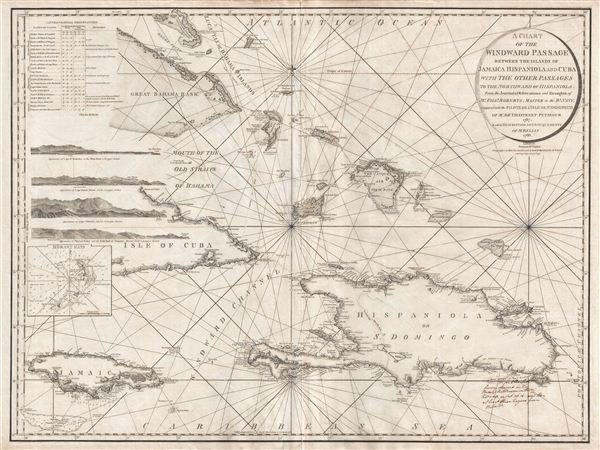This item has been sold, but you can get on the Waitlist to be notified if another example becomes available, or purchase a digital scan.
1795 Faden Map of the Greater Antilles (West Indies): Bahamas, Cuba, Hispaniola
CubaBahamasHispaniola-faden-1795
Title
1795 (dated) 23 x 31 in (58.42 x 78.74 cm)
Description
This extraordinarily detailed and masterfully engraved chart is a product of the final days of Caribbean piracy and privateering. The late 18th and early 19th century saw a resurgence of privateering as successive colonial powers jostled for supremacy in the region. Though piracy was on the rise throughout the Caribbean, nowhere was it more prevalent than in the Windward Passage, a vital maritime trade artery between Cuba and Santo Domingo. This era gave rise to the French pirates Pierre and Jean Lafitte, among the most successful pirates of all time. This map offers some indication that was in fact working sea chart in the form of a curious manuscript annotation in the lower right quadrant correcting the southern coast of Hispaniola.
Cartographically this map is based on earlier French work including Antoine-Hyacinthe de Chastenet Puysegur's 1787 Pilote de l'Isle de St. Domingue and Jacques Nicholas Bellin's 1768 Description des debouquements qui sont au nord de l'Isle de St. Domingue. These and other charts were compiled into this larger chart updated to 1795 by Charles Roberts, a Master in the Royal Navy.
CartographerS
Charles Roberts (1739 - 1825) was a British navigator and nautical surveyor active in the late 18th century. Roberts spent most of his life in the British West Indies and along the coasts of South America where is compiled and updated several nautical charts during his long career as a Master in the Royal Navy. He is specifically credited with three scarce charts focusing on various passages in the Greater Antilles. Rogers did most of his observational work among merchant vessels traversing the West Indies and personally records at least 24 such voyages. Roberts died at Leith in 1825 at the age of 86. More by this mapmaker...
William Faden (July 11, 1749 - March 21, 1836) was a Scottish cartographer and map publisher of the late 18th century. Faden was born in London. His father, William MacFaden, was a well-known London printer and publisher of The Literary Magazine. During the Jacobite Rebellion (1745 - 1746), MacFaden changed his family name to Faden, to avoid anti-Scottish sentiment. Faden apprenticed under the engraver James Wigley (1700 - 1782), attaining his freedom in 1771 - in the same year that Thomas Jefferys Sr. died. While Thomas Jefferys Sr. was an important and masterful mapmaker, he was a terrible businessman, and his son, Jefferys Jr., had little interest in building on his father's legacy. MacFaden, perhaps recognizing an opportunity, purchased his son a partnership in the Jefferys firm, which subsequently traded as 'Faden and Jefferys'. Jefferys Jr. also inherited Jefferys Sr.'s title, 'Geographer to the King and to the Prince of Wales'. With little interest in cartography or map publishing, Jefferys Jr. increasingly took a back seat to Faden, and by 1776, he had withdrawn from day-to-day management, although he retained his financial stake. The American Revolutionary War (1775 - 1783) proved to be a boom for the young 'Geographer to the King', who leveraged existing materials and unpublished manuscript maps to which he had access via his official appointment to publish a wealth of important maps, both for official use and the curious public - this period of prosperity laid the financial underpinning for Faden, who by 1783, at the end of the war, acquired full ownership of the firm and removed the Jefferys imprint. In 1801, he engraved and published the first maps for the British Ordnance Survey. By 1822, Faden published over 350 maps, atlases, and military plans. He retired in 1823, selling his plates to James Wyld Sr. Faden died in 1836. Learn More...
Jacques-Nicolas Bellin (1703 - March 21, 1772) was one of the most important cartographers of the 18th century. With a career spanning some 50 years, Bellin is best understood as geographe de cabinet and transitional mapmaker spanning the gap between 18th and early-19th century cartographic styles. His long career as Hydrographer and Ingénieur Hydrographe at the French Dépôt des cartes et plans de la Marine resulted in hundreds of high quality nautical charts of practically everywhere in the world. A true child of the Enlightenment Era, Bellin's work focuses on function and accuracy tending in the process to be less decorative than the earlier 17th and 18th century cartographic work. Unlike many of his contemporaries, Bellin was always careful to cite his references and his scholarly corpus consists of over 1400 articles on geography prepared for Diderot's Encyclopedie. Bellin, despite his extraordinary success, may not have enjoyed his work, which is described as "long, unpleasant, and hard." In addition to numerous maps and charts published during his lifetime, many of Bellin's maps were updated (or not) and published posthumously. He was succeeded as Ingénieur Hydrographe by his student, also a prolific and influential cartographer, Rigobert Bonne. Learn More...

